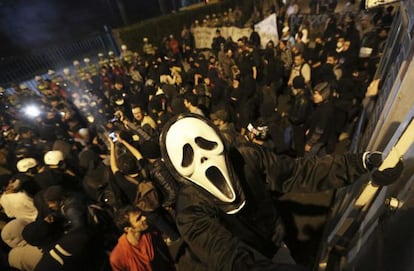Black Bloc: the new unknown element in Brazil’s social unrest
Its members share a hatred of capitalism and attraction for anarchy Its tactics involve the destruction of public property as a language of protest

We are in Avenida Paulista, the financial heart of São Paulo, and a favorite protest venue in this, the wealthiest, most populated, inequality-stricken city in Brazil. A dozen or so youths in black clothes and ski masks break away from the main body of a march and hone in on a bank branch. After kicking away the entrance ramps they turn to the ATMs, which they attack with stones, sticks and spray paint, even after the painfully loud alarms have gone off.
They are fast. They leave their mark and then move on in search of their next target: a McDonald's, a mobile police station or a subway entrance. They are Black Bloc, or better yet, the people who adopt Black Bloc tactics, which involve the destruction of public property as a language of protest. The Black Bloc are not considered a group per se, even though its members share the same hatred of capitalism and attraction for anarchy. This collective, which has already called Brazilians to a national demonstration on September 7, is the new unknown factor in Brazil’s ever-growing street protests.
For the last two months, the country has been trying to analyze the demonstrators marching around on its streets in order to develop some kind of theory that might explain this sudden burst of social agitation. It was the members of Passe Livre, young champions of free public transportation, who staged the first public protests. Then it was the middle-class college students who were unhappy about health, education and safety. Later came the Ninja, activists whose live video feeds triggered complaints against police brutality. Analysts also looked at the role of collectives who are historically known to make social claims, such as the landless, the periphery associations and the residents of the favelas.
Now, it looks like many of the new marches are driven by the Black Bloc, who are hogging all the media and scholarly attention.
The public has already found a name for the Black Bloc: vandals
But theirs is a difficult portrait to paint. While they strive to define themselves as they go along, the public has already found a name for them: vandals. Meanwhile, authorities see them as the quickest way to dissuade the masses from joining the street protests.
The average youth who decides to adopt Black Bloc tactics comes from peripheral neighborhoods where public services such as transportation and healthcare are in even worse shape than in the city center. Outside Brazil, the Black Bloc movement is essentially anticapitalist, with the odd exception, such as Egypt’s masked activists, who were more focused on fighting “the fascist tyranny of the Muslim Brotherhood.” In Brazil, it appears to be a broader movement that seeks a more efficient state and better public services. It is the same banner that was waved in the June protests — now it’s being waved more violently.
Black Bloc activists cover their faces because what they’re doing is a crime. Acts of vandalism are punished with community work, but members who are caught could face prison terms on charges of criminal association. They often act as human shields, putting themselves between the police and the regular protesters at any march.
The brilliance of the Black Bloc’s agenda depends on who you speak to. Being a horizontal organization, they have no leaders, and individual members speak for themselves. But two scholars have analyzed their techniques. Rafael Alcadapini, of the Getúlio Vargas Foundation, and Esther Solano, of Universidad Federal de São Paulo (Unifesp), agree that the Black Bloc lacks a theory and needs to express its claims better, but they say this does not mean it lacks a clear stand or specific demands.
“Most of these youngsters are on the margins of society, but they have read a lot about anarchy and they are articulate. It is no coincidence that they are destroying the symbols of capitalism,” explains Alcadapini.
“They are lower middle-class kids, public school students, periphery residents, and their contact with the country’s problems is much more direct,” adds Solana. “When they talk about violence, they are being very provocative because they are trying to give a new meaning to vandalism. To them, vandalism is being abandoned by the State, it is the overcrowding of the subway, the lines at hospitals, and the violence that they are subjected to on a daily basis.”
Tu suscripción se está usando en otro dispositivo
¿Quieres añadir otro usuario a tu suscripción?
Si continúas leyendo en este dispositivo, no se podrá leer en el otro.
FlechaTu suscripción se está usando en otro dispositivo y solo puedes acceder a EL PAÍS desde un dispositivo a la vez.
Si quieres compartir tu cuenta, cambia tu suscripción a la modalidad Premium, así podrás añadir otro usuario. Cada uno accederá con su propia cuenta de email, lo que os permitirá personalizar vuestra experiencia en EL PAÍS.
¿Tienes una suscripción de empresa? Accede aquí para contratar más cuentas.
En el caso de no saber quién está usando tu cuenta, te recomendamos cambiar tu contraseña aquí.
Si decides continuar compartiendo tu cuenta, este mensaje se mostrará en tu dispositivo y en el de la otra persona que está usando tu cuenta de forma indefinida, afectando a tu experiencia de lectura. Puedes consultar aquí los términos y condiciones de la suscripción digital.
Últimas noticias
Reinhard Genzel, Nobel laureate in physics: ‘One-minute videos will never give you the truth’
Pinochet’s victims grapple with José Antonio Kast’s rise in Chile
From digital curfews to blocking apps: How technology experts protect their children online
Why the price of coffee has skyrocketed: from Brazilian plantations to specialty coffee houses
Most viewed
- Pablo Escobar’s hippos: A serious environmental problem, 40 years on
- Why we lost the habit of sleeping in two segments and how that changed our sense of time
- Trump’s obsession with putting his name on everything is unprecedented in the United States
- Charles Dubouloz, mountaineering star, retires at 36 with a farewell tour inspired by Walter Bonatti
- The Florida Keys tourist paradise is besieged by immigration agents: ‘We’ve never seen anything like this’









































